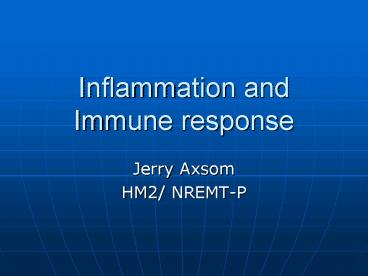Inflammation and Immune response PowerPoint PPT Presentation
1 / 39
Title: Inflammation and Immune response
1
Inflammation and Immune response
- Jerry Axsom
- HM2/ NREMT-P
2
- Purpose of Inflammation and immunuty
- to protect the body from micro-organisms
3
- Invading cells and micro organisms are foreign
proteins called Antigens
4
- The bone marrow is the source of all blood cells
- Including the cells of the immune system
- They are formed there and released into the blood
stream
5
- Bone marrow cells start out as stem cells, then
mature into specific cells - The immune system cells start are white blood
cells or leukocytes
6
- The immune process requires 3 responses
- 1.) inflammation
- 2.) antibody-mediated immunity( humoral immunity)
- 3.) cell- mediated immunity
7
Inflammation
- It is immediate
- It offers short-term protection
- It is a non-specific defence
8
- Inflammation differs from antibody- mediated
immunity and cell- mediated immunity in several
ways - Inflammation can occur without infection
- Infection is usually accompanied by inflammation
9
Cells involved in inflammation
- Leukocutes involved in inflammation
- Neutrophils
- Macrophages
- Eosinophils
- Basophils
10
Neutrophils
- ACCOUNT FOR 67 Of WBC
- Function phagocytosis of foreign protiens
- Mature neutrophils are called segs, polys
- Immature neuts are called bands, stabs
11
Neutrophils
- Neuts are the first line of defence
- Neuts take about 12-14 days to mature
- Only live about 12-18 hrs
- Only take part in one episode of phagocytosis
12
Neutrophils
- A left shift in the WBC refers to an increase in
immature neuts - It also refers to a bacterial infection
13
Monocytes
- 3 of WBC
- When matured they are called Macrophages
- Can live for months to years
- Can be involved in multiple episodes of
phagocytosis
14
Eosinophils
- 1.5 of WBC
- Main function to release chemicals which control
inflammation - Elevated in allergic reactions/ parasitic
infections
15
Basophils
- .5 of WBC
- Responsible for s/s of inflammation
16
Phagocytosis
- 1.) exposure
- 2.) attraction
- 3.) adherence
- 4.) recognition
- 5.) cellular ingestion
- 6.) phagosome formation
- 7.) degration
17
Stages of inflammation
- Manifestations of inflammation
- Warmth
- Redness
- Swelling
- Pain
- Decreased function
18
Stage 1
- Phase 1- rapid short term blood vessel
constriction - Phase 2- vascular (blood vessels)
- Increased blood flow to area
- Increased capillary permeability
- s/s warmth, redness, swelling, pain
19
Stage 2
- Cellular exudate stage
- Formation of exudate (pus)
- Most active WBC in this stage are the NEUTS
- NEUTS attack and destroy foreign substances
20
Stage 3
- Tissue repair and replacement stage
21
Antibody- mediated immunity(humoral immunity)
- Involves antigen- antibody interaction to destroy
foreign protiens - The leukocyte with the most active role in
humoral immunity is the B- lymphocyte
22
B- lymphocyte
- Fromed from stem cells in the bone marrow
- Released into the blood
- Mature in the spleen, lymph nodes, tonsils, and
intestinal tract
23
Acquiring immunity
- Immunity can be natural or acquired
24
Adaptive (acquired ) immunity
- Can be active or passive
- Can be natural or artificial
25
Active
- From our own antibodies
- Can be natural or artifical
- Long term immunity
26
Active
- Natural/ active active- antigen/ antibody
response - Ex person has measles
27
Active
- Artificial/ active
- active- antigen/antibody response
- Ex vaccine for measles
28
Passive
- Natural/ passive mother to fetus
- Artifical/ passive antibodies are injected
- Ex tetnus shot
29
Cell mediated immunity
- Lymphocytes 28 of WBC
- shift to right viral infection
- main lymp T-lymp
- Cell mediated immunity involves the ability to
differentiate self from non self
30
Cell mediated immunity
- Natural killer cells destroy cells from other
people or animals. This results in rejection of
transplanted organs/ tissues - These people need to take immunosuppressants or
anti rejection meds
31
Connective tissues
- Connective tissue disorders are auto immune
disorders that cause chronic pain, loss of
function, and are crippling
32
Osteoarthritis
- Noninflammatory
- Non systemic
- Not auto immune
- Joints lose cartilage and rub on each other, may
have bone sours, or subluxation (dislocation) - Also have crepitus
- Or ballottment floating patella
33
OA
- Total hip
- most common joint replaced
- can last about 20 years
34
Rheumatoid Arthritis
- Most common connective tissue disease and is most
destructive to joints
35
RA
- Chronic, progressive, systematic, inflammatory
auto immune disease - Antibodies (RFs) are formed and attack healthy
tissue
36
RA
- RA is caused by a combination of genetic and
environmental factors not clearly understood - With RA you usually feel better with activitry
unlike OA - Pattern of joint involvement is typically
bilateral and symmetric - Pain, decreased ROM, joints feel like jelly
37
Lupus erythematosus
- Discoid lupus erythematosus(DLE) butterfly rash
on face - SLE- chronic, progressive, inflammatory
connective tissue disorder that attacks major
body tissues
38
Gout
- Systemic disease which urate crystals deposit in
the joints causing inflammation - Primary gout most common, an end product of this
metabolism is uric acid, which is usually
excreted by the kidneys - The acid is deposited in the synovium
39
Fibromyalgia
- Chronic pain syndrome, not inflammatory disease
- Unknown what causes disease, though to be a
dysfunction in the brain r/t pain center

